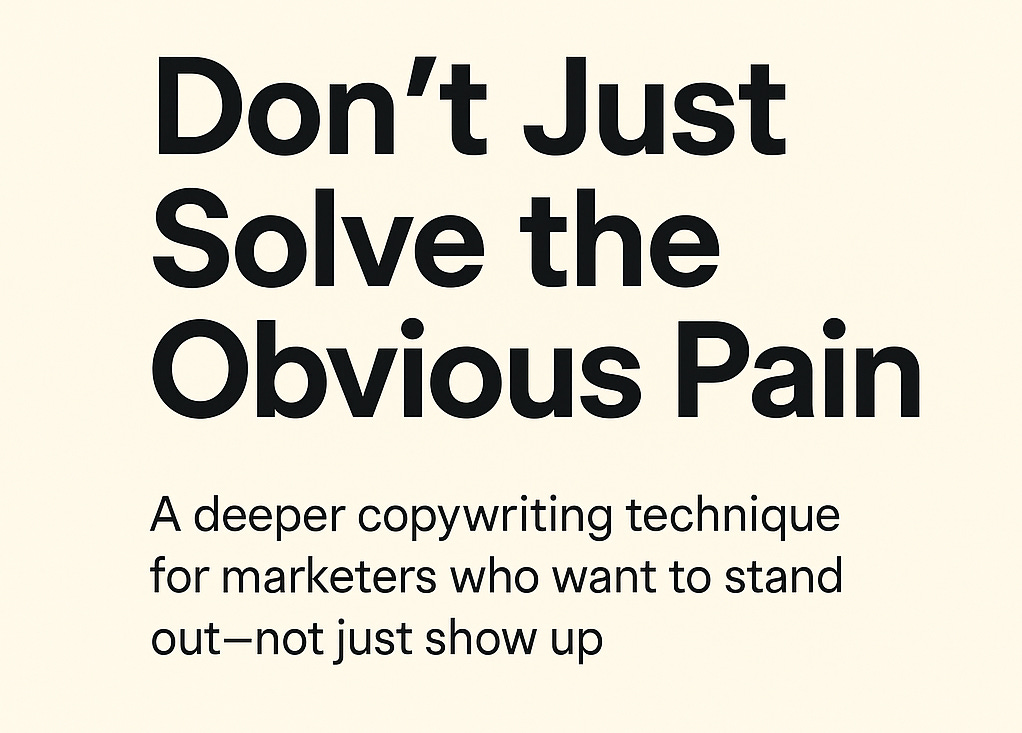Sell the Pain behind the Pain
First order vs Second order pain
Let me show you something.
There’s a kind of copy that reads well. It lists problems. Sounds smart.
But doesn’t convert.
And then there’s another kind. It cuts deeper.
It gets the “yes.”
The difference?
The first one speaks to first-order pain.
The second one hits second-order pain.
Let me explain.
What most advice tells you
When people talk about writing copy, they’ll say:
“Start with the pain. Agitate it. Then offer the solution.”
Fair.
But here’s the catch: most people stop at the obvious pain.
“You’re wasting too much time.”
“Your leads are not converting.”
“Your costs are rising.”
All true.
But it’s not enough.
Because that’s not why people really buy.
What I learned the hard way
In one of our older product pages, we said:
“Automate your order tracking and save 10 hours a week.”
It made sense.
It was useful.
It flopped.
When we rewrote it, we said:
“Stop drowning in ‘where is my order?’ emails.
Get your time and sanity back.”
That version hit a nerve.
People clicked. Trials went up.
Why?
Because the first one talks to the brain.
The second one speaks to the self-image.
That’s second-order pain.
First-order vs. Second-order pain
Let’s unpack this:
First-order pain: the visible inconvenience.
Second-order pain: the emotional consequence.
Some examples:
You say they’re wasting time →
They feel: “I can’t focus on real work.”You say they’re overspending →
They feel: “I’m failing at managing my budget.”You say their site is slow →
They feel: “People think we’re unprofessional.”
Second-order pain isn’t louder.
It’s heavier.
It doesn’t shout. It whispers something personal.
And people don’t always tell you this in interviews.
But they feel it when they see it in your copy.
Real copy tweaks (before → after)
Let’s look at how small rewrites can shift the entire tone:
Before:
“Too many tools are eating up your budget.”
After:
“You’re not just paying for tools.
You’re paying for mistakes you didn’t sign up for.”
Before:
“Low traffic? Boost your site visitors today.”
After:
“Low traffic doesn’t just hurt your numbers.
It makes you question everything.”
Before:
“Clear your inbox with our AI email assistant.”
After:
“Finally — a way to feel in control again.”
These aren’t just lines. They’re mirrors.
They show your audience something they haven’t said out loud,
but they deeply recognize.
That’s what moves people.
Why this matters
When you write to second-order pain, your copy stops sounding like a pitch.
It starts sounding like someone who understands.
That’s rare.
And that’s what gets remembered.
People don’t buy features.
They don’t even buy outcomes.
They buy the feeling of relief.
Of redemption.
Of being seen.
Try this
When writing your next copy block:
List the user’s obvious pain.
e.g. Wasting time, low conversions, confusion.Ask yourself:
“What does this make them feel about themselves?”Write to that.
Speak to that quiet part.
You’ll notice something.
The copy hits harder.
Because it’s more human.
And that’s what gets the yes.


